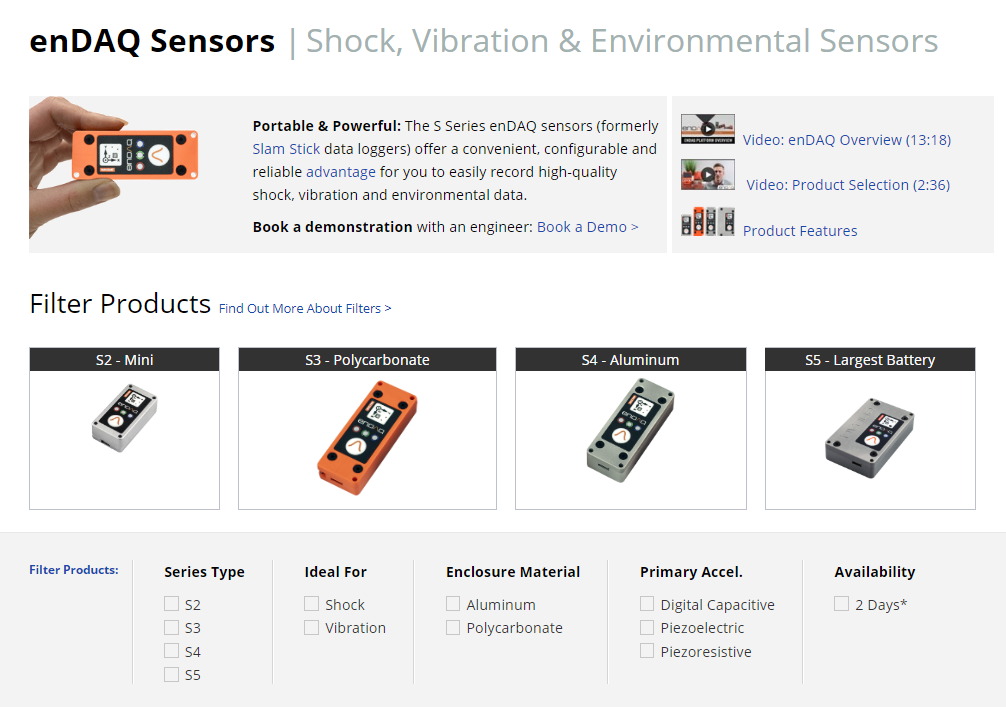You know you need a vibration data logger, but what are your choices? And what are some of the best options?
In our 6 ways to measure vibration post, we highlighted 6 very different products; only 3 of which were vibration data loggers. In this post I'll focus on vibration data loggers and compare the top 11 that I've come across. I'll then dive a bit deeper and review 4 different product lines from 4 different companies. I'll also provide links to all these products so you can do some additional research on these vibration recorders. If you are interested in wireless options, check out a similar post highlighting wireless monitoring systems.
Full disclosure is that I have some skin in the game and work at one of the companies showcased. But don't think that disqualifies me from comparing the options out there! I believe that I have a unique perspective because I continually work to educate myself on the competition we face. I'm excited to share with you what I've learned to help you decide which product best meets your vibration data logging needs!
All 11 Vibration Recorders
In the following table I've reviewed the top 11 vibration data loggers commercially available. The table compares pricing, maximum sample rate, measurement range and recording length. Recording length is heavily dependent on sample rate and the triggering you utilize - to simplify in this table, I went with using the maximum recording length available to you when continuously recording at the product's maximum sample rate. This is limited by both battery life and storage space.
I also reviewed each product on a 3 point scale based on my perception of their value, and how much performance you get per dollar spent? The ones that received three stars are reviewed in more depth below and are products that I believe offer a fair amount of performance for their cost. The ones that received one star, in my opinion, offer very poor value and are products that are clearly using older designs/technology.
| Product Name | Company | Price | Max Sample Rate | Range | Recording Length | Review |
| HOBO Pendant | Onset | $83 | 100 Hz | ±3g | 168 hours | |
| VB300 | Extech | $210 | 200 Hz | ±18g | 15 minutes | |
| Vibration Sentry | Convergence Instruments | $344 | 3,200 Hz | ±16, 200g | 42 minutes | |
| SVR101 | MadgeTech | $599 | 256 Hz | ±50g | 4 hours | |
| enDAQ S3-D40 | enDAQ (a division of Mide) | $1,250 | 4,000 Hz | ±40g | 13 hours | |
| enDAQ S4 Series | enDAQ (a division of Mide) | $2,500 | 20,000 Hz | ±25g, 100g, 500g, 2000g | 5 hours | |
| MSR165 | MSR | $1,271 | 1,600 Hz | ±15, 200g | 7 hours | |
| ShockLog 298 | Shock Watch | $2,400 | 4,096 Hz | ±200g | 15 minutes | |
| enDAQ (a division of Mide) | $3,000 | 20,000 Hz | ±25g, 100g, 500g, 2000g | 17 hours | ||
| TSR Pro | DTS | >$6,000 | 20,000 Hz | ±20g, 50g, 250g | 4 hours | |
| EDR-3C | IST | >$7,500 | 3,200 Hz | ±2g to 500g | 1 hour |
Next I want to showcase 4 different product lines spanning from low-end to high-end recording systems. I routinely point customers and potential customers of ours to some of these next competing products when ours is either too expensive, or not robust or advanced enough to meet their needs.
The Best Four Data Logging Product Lines
1) Low-End: HOBO Pendant
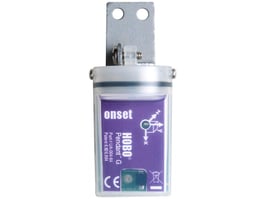 There are a ton of very low cost options out there for "vibration" testing. Most of these products aren't providing much more than what a cell phone app can offer; but there is one on the low end that stands out. If your application only requires a sample rate of 100 Hz or less, and cost is a major concern, then the HOBO Pendant is the product for you.
There are a ton of very low cost options out there for "vibration" testing. Most of these products aren't providing much more than what a cell phone app can offer; but there is one on the low end that stands out. If your application only requires a sample rate of 100 Hz or less, and cost is a major concern, then the HOBO Pendant is the product for you.
It has a very long battery life and can last a week when recording at 100 Hz. It is available at the very reasonable price of $83.
2) Mid to Low-End: Vibration Sentry
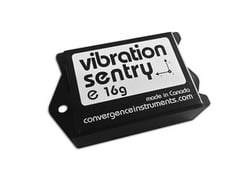 If you can afford a couple hundred dollars more, then it is well worth it to upgrade to Convergence Instrument's Vibration Sentry. These come in either a ±16g or ±200g model and can sample up to 3,200 Hz in each axis. The other products in this similar price range typically are limited to sample rates of a few hundred hertz.
If you can afford a couple hundred dollars more, then it is well worth it to upgrade to Convergence Instrument's Vibration Sentry. These come in either a ±16g or ±200g model and can sample up to 3,200 Hz in each axis. The other products in this similar price range typically are limited to sample rates of a few hundred hertz.
Their 16g version is available for $344 and the 200g model is sold for $379. These are likely using Analog Device's ADXL345 and ADXL375 accelerometers respectively. They appear fairly robust and have good triggering options. They only have 128 MB of storage though which limits the maximum recording time to 42 minutes when sampling at 3,200 Hz.
3) Mid to High-End: enDAQ Sensors (formerly Slam Stick)
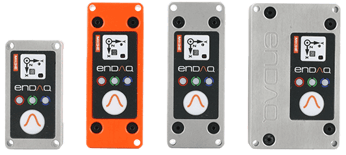 Getting out of the fray that is on the lower end, enDAQ products (formerly Slam Stick) start adding in more sensing capabilities and better sensors to serve a wider range of applications. The vibration data logger products range from the S2 to the S5. They all include a suite of other environmental sensors including temperature, pressure, humidity, light, gyroscope, and magnetometer.
Getting out of the fray that is on the lower end, enDAQ products (formerly Slam Stick) start adding in more sensing capabilities and better sensors to serve a wider range of applications. The vibration data logger products range from the S2 to the S5. They all include a suite of other environmental sensors including temperature, pressure, humidity, light, gyroscope, and magnetometer.
All of the loggers include at least 1 GB of storage (500 million samples) while most have 8 GB (4 billion samples). This is probably, in addition to just how many sensors are included, set the enDAQ loggers apart. The most important selection between units is the primary accelerometer type (digital capacitive, piezoelectric, or piezoresistive) and range; but most units contain two triaxial accelerometers to widen the dynamic range. For a deeper breakdown on accelerometer types, check out our blog on accelerometer selection.
To highlight a few good products to choose between would be the entry S3-D40 at $1,250 with a surprisingly high quality digital accelerometer of 40g and very low noise (<0.01 gRMS). Next would be to choose a S3-E100D40 for a wider amplitude and frequency range of a 100g piezoelectric accelerometer allowing sampling up to 20,000 Hz and costing $2,000. Then would be to step up to the S4-R2000D40 which has a piezoresistive accelerometer with a 2,000g range and costs $2,500. Then the S5-E100D40 has the largest battery offering continuous recording of 40 hours or with triggering recording for a week!
There are about 20 different variants to chose from depending on accelerometer type and enclosure type / size. Our interactive catalog page shown above easily allows you to filter by whichever combination of parameters you choose. The costs will range from $1,000 to $4,000 depending on these factors.
4) High-End: TSR Pro-HB
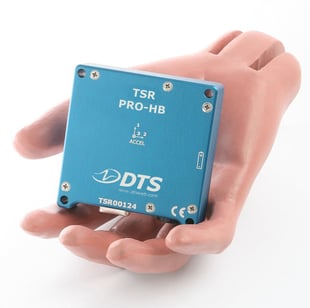 The TSR Pro-HB has similar performance specifications compared to enDAQ's S5-R2000D40 product. They both have high measurement range options (DTS up to 500g, enDAQ up to 2,000g), offer a fast sample rate up to 20,000 Hz, and extensive storage at over 1 GB. I'm not exactly sure what accelerometer type they are using but I think (hope) they are using piezoresistive like the S5-R2000D40. They do have some higher end models too called the TSR 3DXP or TSR 6DXP which include a gyroscope and pressure sensor.
The TSR Pro-HB has similar performance specifications compared to enDAQ's S5-R2000D40 product. They both have high measurement range options (DTS up to 500g, enDAQ up to 2,000g), offer a fast sample rate up to 20,000 Hz, and extensive storage at over 1 GB. I'm not exactly sure what accelerometer type they are using but I think (hope) they are using piezoresistive like the S5-R2000D40. They do have some higher end models too called the TSR 3DXP or TSR 6DXP which include a gyroscope and pressure sensor.
DTS really starts to shine though when you have a need for multiple external sensors all wired together. Their data acquisition systems are much more portable and rugged compared to traditional systems like National Instruments.
Summary
There are a variety of vibration data logger products out there; hopefully my initial summary table with links saved you a bit of time. And I would encourage you to limit your choices to these 4 product lines I just showcased to make it easier for you to perform a cost/performance trade-off study.
If you liked the format of the post but are interested in wireless, check out a similar post highlighting wireless monitoring systems.
If you'd like to learn a little more about various aspects and choices available to you in shock and vibration testing and analysis, download our free Shock & Vibration Testing Overview eBook. In there are some examples, background, and a ton of links to where you can learn more. And as always, don't hesitate to reach out to us if you have any questions!
Related Posts:
- 6 Ways to Measure Vibration
- Shock & Vibration of the Wrist in Different Sports
- Why the Power Spectral Density (PSD) Is the Gold Standard of Vibration Analysis
For more on this topic, visit our dedicated Vibration Loggers & Vibration Sensors resource page. There you’ll find more blog posts, case studies, webinars, software, and products focused on your vibration testing and analysis needs.

